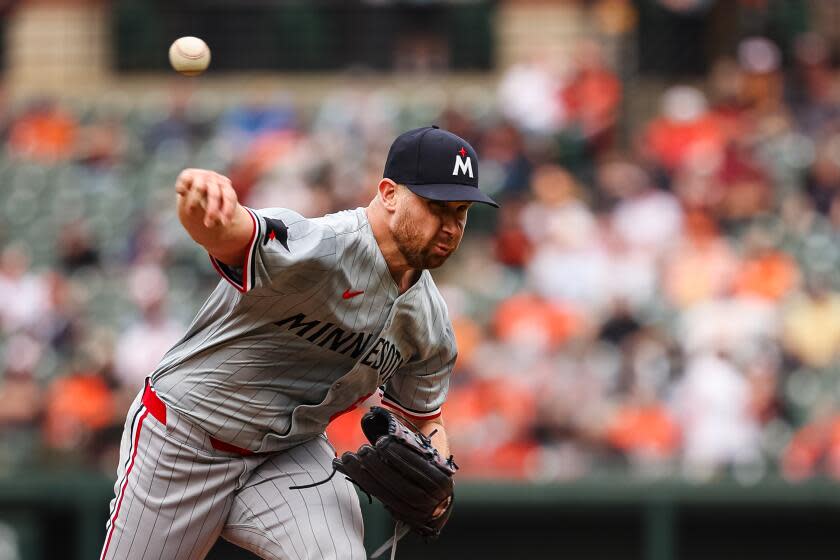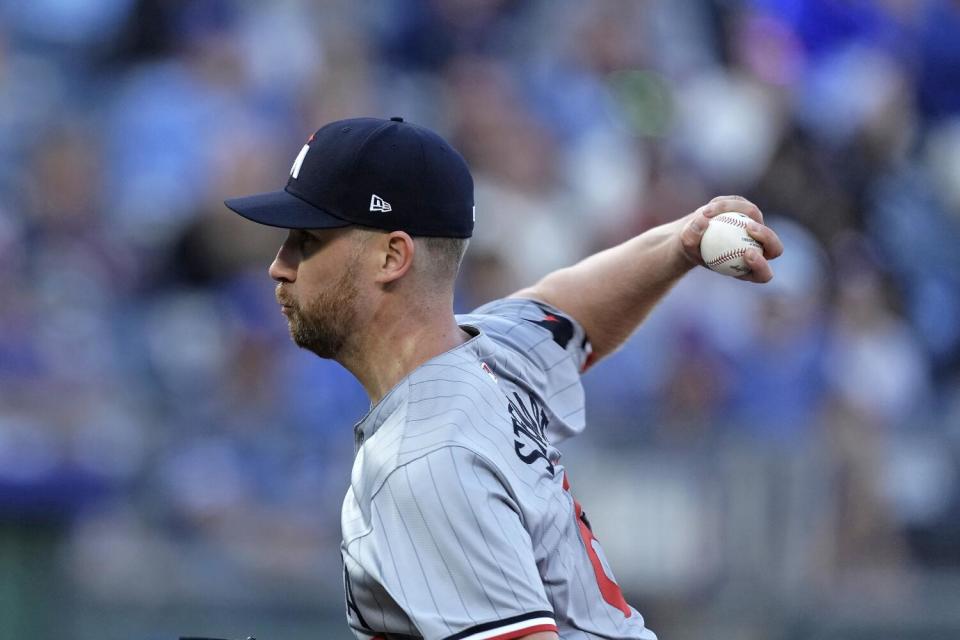Shaikin: Risk and reward: This ex-Dodger used to throw 91 mph. Now he throws 97

Brock Stewart arrived in Anaheim over the weekend throwing 97 mph, and where was that when he pitched for the Dodgers?
It’s a long story, and a good one. It also puts a face on the issue that has dominated the major league conversation this month: What is causing all these pitching injuries, and what can we do about them?
Stewart, now pitching for the Minnesota Twins, made his major league debut with the Dodgers in 2016. In his first home start, he pitched five shutout innings. He still has a recording of the game.
“Vin Scully called it,” Stewart said. “I will cherish that forever.
“I loved my time with the Dodgers. That’s about as big league as you get: Dodger Stadium, and Hollywood.”
Read more: Oldest living MLB player turns 100, vividly recalls facing Dodgers in 1953 World Series
For four years, the Dodgers shuttled him between the starting rotation and the bullpen, and between the majors and the minors. In 2018, his average fastball dipped from 93 mph to 91 mph.
From the middle of 2019 to the middle of 2020, he journeyed from three organizations — the Dodgers, Toronto Blue Jays and Chicago Cubs — to the independent Chicago Deep Dish. The uniform top there was covered, if you will, with what Stewart described as “a deep dish slice, with melted cheese falling off of it.”
As summer turned to fall in 2020, Stewart and his wife hosted a barbecue, and one of the guests — “a friend of a friend’s boyfriend” — ran a baseball development facility called Tread Athletics.
Driveline is the brand name in the field, but the common goal is better performance through intensive analysis. For pitchers, throwing harder can be a goal in itself, not a byproduct of a new workout routine.
Within weeks after he got on the Tread program, his velocity spiked. Five months later, he had Tommy John surgery.

“At 29 years old, I gained 5 mph in two months, so that sudden jump? I’m sure that’s what led to my elbow breaking down,” Stewart said.
“Do I know that for a fact? No. I don’t think anybody does. But I think you’d be silly to say the added velocity doesn’t play a big part.”
He is not blaming Tread. Far from it. Without training there before and after the surgery — rebuilding his delivery so his hips and arm path were more efficient; building his flexibility, mobility and strength; and, yes, cranking up his velocity — he says he wouldn’t be here.
Stewart has emerged as one of the most effective relievers in the majors. In 39 appearances with the Twins this season and last, he has been scored upon once. His ERA this season: 0.00.
He also spent three months of last season on the injured list because of what the Twins called “right elbow soreness.”
Said Stewart: “I don’t regret anything. I’m here now. I’m helping out a good team. Injuries are part of the game. I know that part of the game.”
Read more: How athletes and entertainers like Shohei Ohtani get financially duped by those they trust
Higher velocity correlates with success and also with an increased risk of injury. The proper balance is something of a holy grail.
Pitch counts and innings limits are rudimentary and generalized measures, borne more of common sense than decades of data. The same goes for teams putting pitchers on the injured list because of soreness that might or might not foretell a serious injury.
What we really need — and biomechanical data should be able to help — are individualized injury prevention guidelines. The Dodgers are working on that, and they are not alone.
“From an evidentiary standpoint, it is clear that, as an industry, we don’t know a lot,” said Andrew Friedman, the Dodgers’ president of baseball operations. “I think that’s a really important starting point.
“As we have access to more and more information, there is no question we will be smarter on this front a year from now. That had better continue as far as we can see out, if we have a chance of slowing down this epidemic.”
The 30 major league teams paid more than $1 billion to injured players last season, according to Stan Conte, a former Dodgers head athletic trainer. Conte now runs his own injury analytics operation, and he is working with a data scientist on how to determine which players are at highest risk of injury.

Unfortunately for Stewart, high velocity and previous injury are two prominent risk factors. Conte and his partner have put together a panel of 37 factors that can contribute to injury risk for pitchers, with everything from pitch count, age, height and weight to the variance in release point on individual pitches.
The overall risk is then assessed as high, moderate or low, with the risk changing after inputs from each appearance. For instance, an elbow dropping below its usual slot in one start could indicate fatigue, which increases risk.
However, as Conte acknowledged, he and other researchers have yet to be able to provide the answers teams really want: Which factors are the ones most likely to lead to injury, and what exactly should a team do about a pitcher assessed at high risk?
Conte agreed to pull up Stewart’s profile and tell us what he saw — not all 37 factors, but the overall risk.
“I would say,” Conte said, “this guy does not have a significant risk.”
This story originally appeared in Los Angeles Times.

